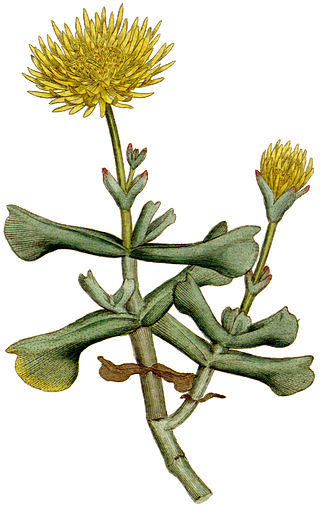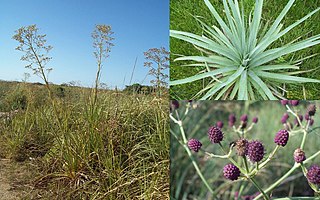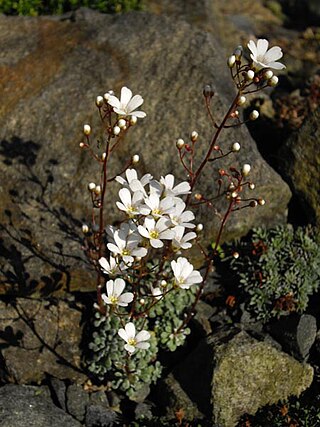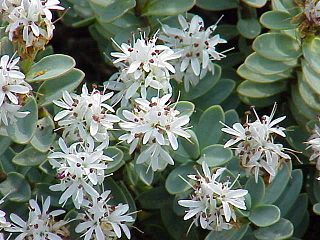
Trillium erectum, the red trillium, also known as wake robin, purple trillium, bethroot, or stinking benjamin, is a species of flowering plant in the family Melanthiaceae. The plant takes its common name "wake robin" by analogy with the European robin, which has a red breast heralding spring. Likewise Trillium erectum is a spring ephemeral plant whose life-cycle is synchronized with that of the forests in which it lives. It is native to the eastern United States and eastern Canada from northern Georgia to Quebec and New Brunswick.

Pelargonium is a genus of flowering plants that includes about 280 species of perennials, succulents, and shrubs, commonly called geraniums, pelargoniums, or storksbills. Geranium is also the botanical name and common name of a separate genus of related plants, also known as cranesbills. Both genera belong to the family Geraniaceae. Carl Linnaeus originally included all the species in one genus, Geranium, and they were later separated into two genera by Charles Louis L'Héritier de Brutelle in 1789.

Salix acutifolia, also known as Siberian violet-willow, long-leaved violet willow or sharp-leaf willow, is a species of flowering plant in the family Salicaceae, native to Russia and eastern Asia. It is a spreading, deciduous shrub or tree, growing to 10 m (33 ft) tall by 12 m (39 ft) wide. The young shoots are deep purple with a white bloom. The leaves are narrow, up to 10 cm (4 in) long. The catkins are produced in early spring, before the leaves. Older bark has a fine, netted pattern.

Phlomis chrysophylla, the golden-leaved Jerusalem sage, is a species of flowering plant in the family Lamiaceae, native to southwest Asia. It is an evergreen shrub growing to 1 m (3 ft) tall by 1.2 m (4 ft) wide, with woolly-textured, sage-like leaves that turn lime green with age, and yellow flowers carried in the leaf axils in early summer.

Rhombophyllum is a genus of succulent plants in the ice plant family, Aizoaceae. Members of the genus are native to southern Africa.
Cyananthus microphyllus, called the small-leaved bluebell-flower, is a species of flowering plant in the genus Cyananthus, native to the western Himalayas, Nepal, and Tibet. It has gained the Royal Horticultural Society's Award of Garden Merit.

Eryngium pandanifolium, or pandan-like-leaved eryngo, is a species of flowering plant in the genus Eryngium, native to Brazil, Paraguay, Uruguay, and Argentina, and introduced in Australia, New Zealand, and Portugal. It has gained the Royal Horticultural Society's Award of Garden Merit.
Euphorbia nereidum, called the nerium-leaved spurge, is a species of flowering plant in the genus Euphorbia, native to Morocco. It has gained the Royal Horticultural Society's Award of Garden Merit.
Philodendron angustisectum, called the cut-leaved philodendron, is a species of flowering plant in the genus Philodendron, disjunctly found in Bolivia and Colombia. It has gained the Royal Horticultural Society's Award of Garden Merit as a hothouse ornamental.

Primulina dryas, called the oak-nymph-leaved primulina, is a species of flowering plant in the genus Primulina, native to southeast China. It has gained the Royal Horticultural Society's Award of Garden Merit.

Conophytum longum, called the long-leaved cone plant, is a species of flowering plant in the genus Conophytum, native to the western Cape Provinces of South Africa. It has gained the Royal Horticultural Society's Award of Garden Merit.

Tillandsia argentea, called the silver-leaved air plant, is a species of flowering plant in the bromeliad genus Tillandsia, native to Cuba and Jamaica. An evergreen perennial epiphyte, it has gained the Royal Horticultural Society's Award of Garden Merit as a houseplant.

Ranunculus gramineus, called the grass-leaved buttercup, is a species of flowering plant in the genus Ranunculus, native to the western Mediterranean; Morocco, Algeria, Tunisia, Portugal, Spain, France, Italy, and Switzerland. It has gained the Royal Horticultural Society's Award of Garden Merit.

Saxifraga cochlearis, called the spoon-leaved saxifrage, is a species of flowering plant in the genus Saxifraga, native to the Alpes Maritimes of France and the adjoining Italian region of Liguria. Its 'Minor' subtaxon has gained the Royal Horticultural Society's Award of Garden Merit.

Santolina pinnata, called lavender cotton along with other members of its genus, is a species of flowering plant in the family Asteraceae, native to northwest Italy. Its putative subspecies Santolina pinnata subsp. neapolitana, the rosemary-leaved lavender cotton, has gained the Royal Horticultural Society's Award of Garden Merit.

Sorbaria tomentosa, the Himalayan sorbaria or Kashmir false spirea, is a species of flowering plant in the family Rosaceae. A shrub with white flowers that can grow up to 6 metres in height. It is native to Afghanistan, Central Asia and the Himalayas, and has been introduced to the South Island of New Zealand. It has gone extinct in Tajikistan. Its putative variety Sorbaria tomentosa var. angustifolia, the narrow-leaved Himalayan sorbaria, has gained the Royal Horticultural Society's Award of Garden Merit.

Bistorta vacciniifolia, the whortleberry-leaved knotweed, is a species of flowering plant in the family Polygonaceae, native to Tibet and the Himalaya. Well-suited for clay soils, as its synonym Persicaria vacciniifolia it has gained the Royal Horticultural Society's Award of Garden Merit.
Diascia integerrima, the entire-leaved twinspur, is a species of flowering plant in the family Scrophulariaceae, native to South Africa and Lesotho. It is the hardiest of the twinspurs, to USDA zone 6a. It gained the Royal Horticultural Society's Award of Garden Merit in 1995, but the award appears to have been recently revoked.

Veronica pinguifolia, the disk-leaved hebe or thick-leaved speedwell, is a species of flowering plant in the family Plantaginaceae, native to the South Island of New Zealand. Under its synonym Hebe pinguifolia, its cultivar 'Pagei' has gained the Royal Horticultural Society's Award of Garden Merit.

Alyssum serpyllifolium, the thyme-leaved alison, is a species of flowering plant in the family Brassicaceae, native to the western Mediterranean region. It is adapted to serpentine soils. The Royal Horticultural Society recommends it for rock gardens.















